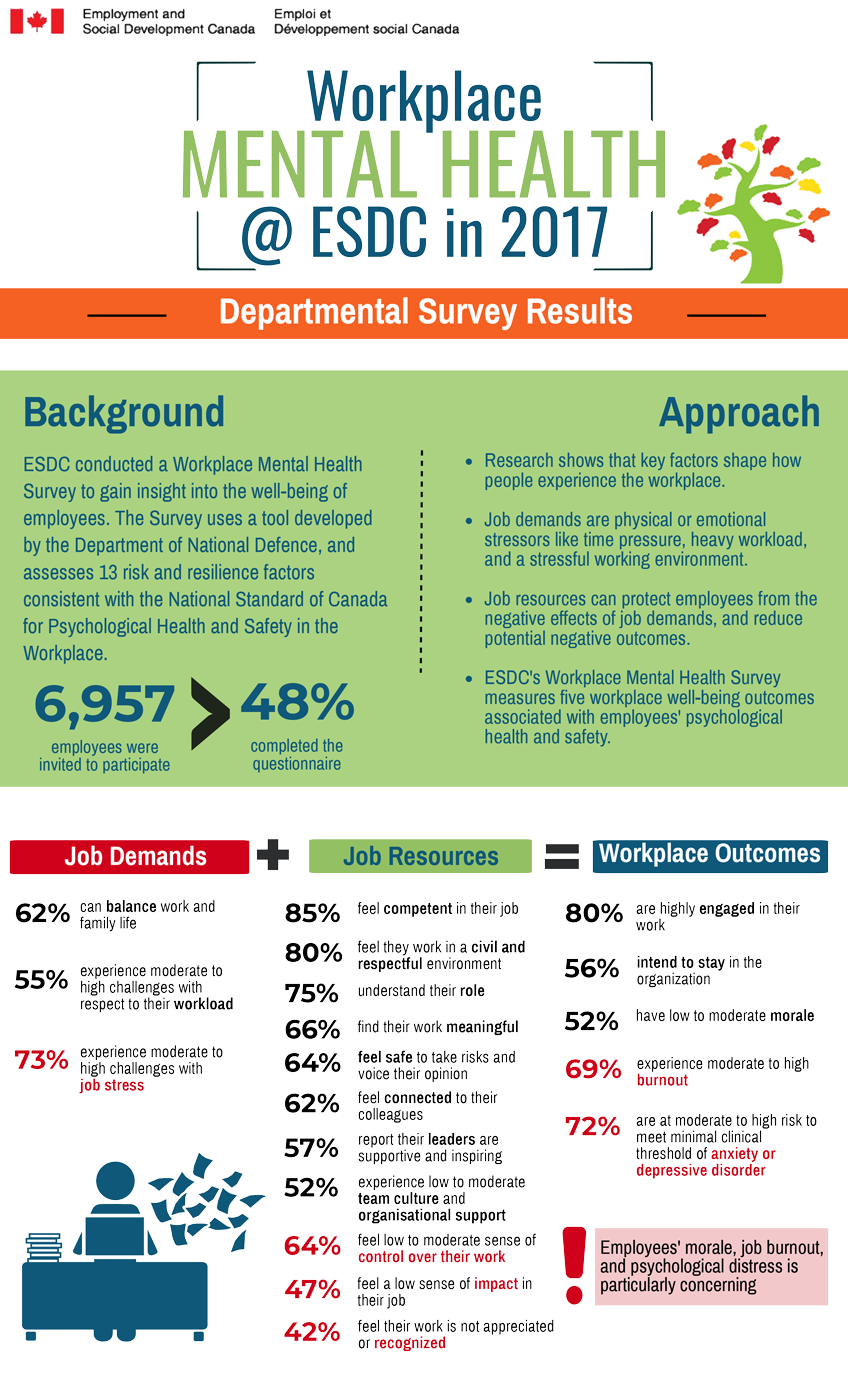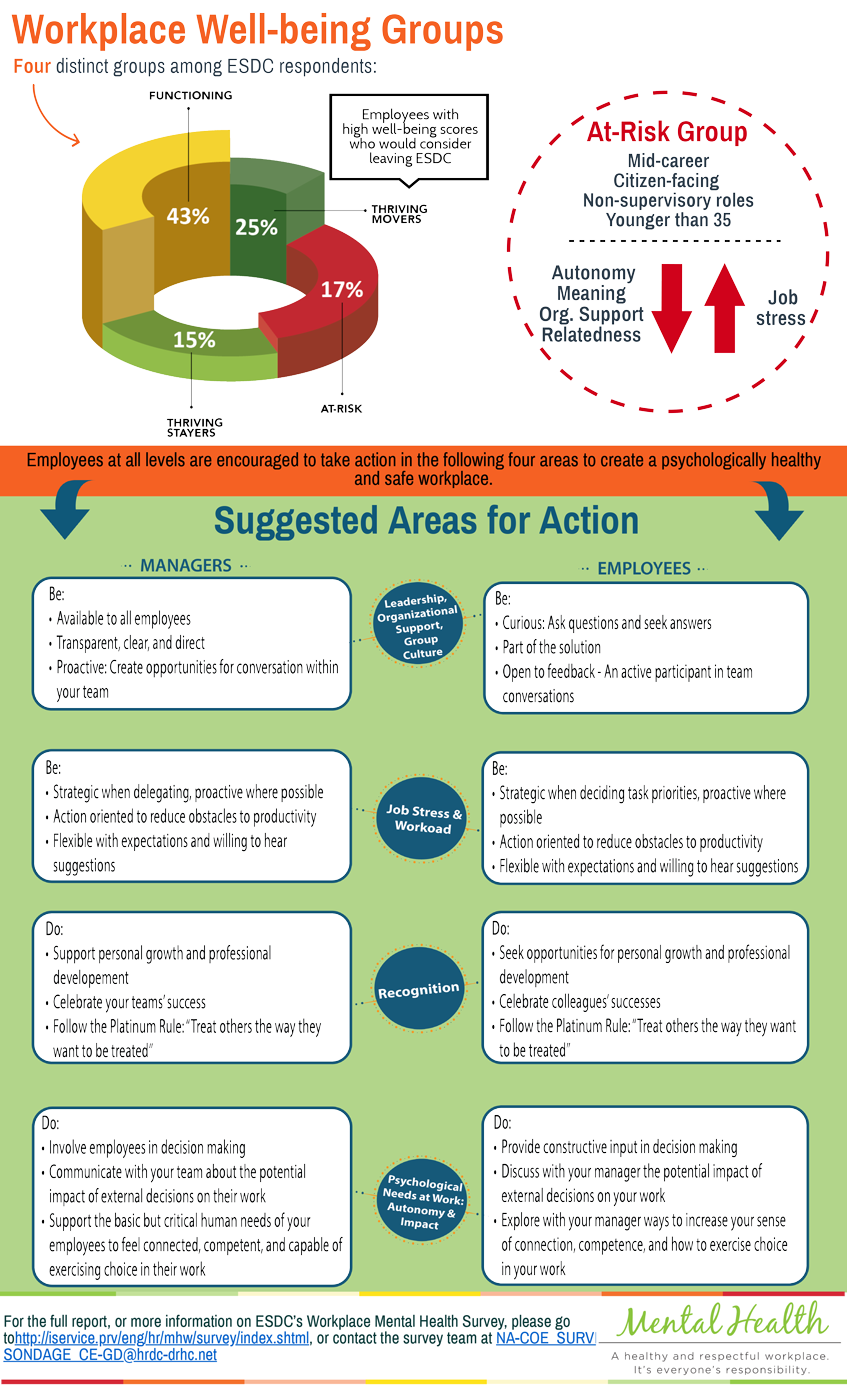Workplace Mental Health @ ESDC in 2017


Click on the image to access the hyperlinks.
Workplace Mental Health @ ESDC in 2017 - Long description.
Departmental Survey Results
- Background
-
ESDC conducted a Workplace Mental Health Survey to gain insight into the well-being of employees. The Survey uses a tool developed by the Department of National Defence, and assesses 13 risk and resilience factors consistent with the National Standard of Canada for Psychological Health and Safety in the Workplace.
6,957 employees were invited to participate
48% completed the questionnaire
- Approach
-
- Research shows that key factors shape how people experience the workplace.
- Job demands are physical or emotional stressors like time pressure, heavy workload, and a stressful working environment.
- Job resources can protect employees from the negative effects of job demands, and reduce potential negative outcomes.
- ESDC's Workplace Mental Health Survey measures five workplace well-being outcomes associated with employees' psychological health and safety.
-
Job Demands
-
62% can balance work and family life
55% experience moderate to high challenges with respect to their workload
73% experience moderate to high challenges with job stress
-
Job Resources
-
85% feel competent in their job
80% feel they work in a civil and respectful environment
75% understand their role
66% find their work meaningful
64% feel safe to take risks and voice their opinion
62% feel connected to their colleagues
57% report their leaders are supportive and inspiring
52% experience low to moderate team culture and organisational support
64% feel low to moderate sense of control over their work
47% feel a low sense of impact in their job
42% feel their work is not appreciated or recognized
-
(Job Demands +
Job Resources) =
Workplace Outcomes
-
80% are highly engaged in their work
56% intend to stay in the organization
52% have low to moderate morale
69% experience moderate to high burnout
72% are at moderate to high risk to meet minimal clinical threshold of anxiety or depressive disorder
Employees' morale, job burnout, and psychological distress is particularly concerning
Workplace Well-being Groups
There are four distinct groups among ESDC respondents:
- 43% of respondents are described as Functioning
- 25% as Thriving Movers (Employees with high well-being scores who would consider leaving ESDC)
- 17% as At-risk
- 15% 15% as Thriving Stayers
At-Risk Group: those in mid-career; who are citizen facing; in non-supervisory roles; or younger than 35.
Five key predictors that increase a respondent's likelihood of being at-risk:
- lower levels of autonomy
- less meaningfulness at work
- less organizational support
- a reduced sense of belonging
- elevated levels of job stress
Employees at all levels are encouraged to take action in the following four areas to create a psychologically healthy and safe workplace.
Suggested Areas for Action
Leadership, Organizational Support, Group Culture
Leadership, Organizational Support, Group Culture
- Managers
-
Be:
- Available to all employees
- Transparent, clear, and direct
- Proactive: Create opportunities for conversation within your team
- Employees
-
Be:
- Curious: Ask questions and seek answers
- Part of the solution
- Open to feedback - An active participant in team conversations
Job Stress and Workload
- Managers
-
Be:
- Strategic when delegating, proactive where possible
- Action oriented to reduce obstacles to productivity
- Flexible with expectations and willing to hear suggestions
- Employees
-
Be:
- Strategic when deciding task priorities, proactive where possible
- Action oriented to reduce obstacles to productivity
- Flexible with expectations and willing to hear suggestions
Recognition
- Managers
-
Do:
- Support personal growth and professional development
- Celebrate your teams' success
- Follow the Platinum Rule: "Treat others the way they want to be treated"
- Employees
-
Do:
- Seek opportunities for personal growth and professional development
- Celebrate colleagues' successes
- Follow the Platinum Rule: "Treat others the way they want to be treated"
Psychological Needs at Work: Autonomy and Impact
- Managers
-
Do:
- Involve employees in decision making
- Communicate with your team about the potential impact of external decisions on their work
- Support the basic but critical human needs of your employees to feel connected, competent, and capable of exercising choice in their work
- Employees
-
Be:
- Provide constructive input in decision making
- Discuss with your manager the potential impact of external decisions on your work
- Explore with your manager ways to increase your sense of connection, competence, and how to exercise choice in your work
For the full report, or more information on ESDC’s, please go to Workplace Mental Health Survey, or contact the survey team at na-coe_survey-sondage_ce-gd@hrdc-drhc.net